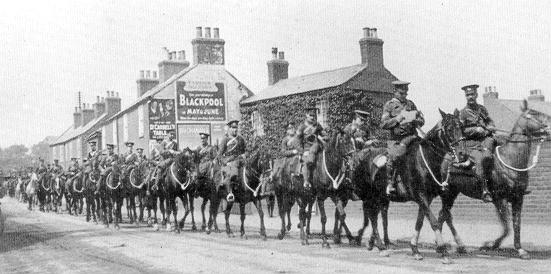 Leicestershire Yeomanry leaving the town on their way to camp. The WW1 Roll of Honour is a complete list of all 592 men from Loughborough who lost their lives in the Great War. It includes not only the names of 478 men engraved on the bronze memorial tablets of the Carillon Tower, but also the names of 114 other men who died and whose names are all missing from the Memorial in Queen's Park. The original list of soldiers whose names are to be found on the Carillon Tower is given in The List of the Fallen at the end of the web page on The History of the Memorial. Searching the Roll of Honour Men on the Roll of Honour are arranged in alphabetical order by surname. There are two ways of finding a particular man on the Roll, as follows:
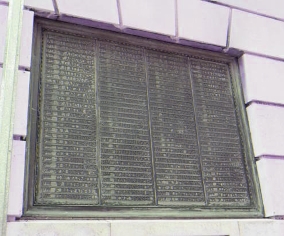 One of the bronze plaques on the side
of the Carillon Tower, Queens Park, listing 478 of the Loughborough fallen.
Names Missing from the Carillon War Memorial The omission of the 114 names was discovered by Marigold Cleeve, Principal Researcher for the Carillon War Memorial Museum, when she was editing and expanding the electronic Loughborough Roll of Honour. How could this have happened? How were the names of the Fallen collected? It appears that members of the Loughborough War Memorial Committee went round workplaces collecting names for the memorial, although whether they visited schools and churches as well is unknown. According to Maurice Bray, in his book Bells of Memory which is a history of the Carillon, the War Memorial Committee became rather concerned that despite public meetings, voting for the Carillon project and works visits by the War Memorial Committee there were still many people in Loughborough and district who did not seem to know what the Carillon was for. So the War Memorial Committee published a 16 page booklet which was issued to every household in the Borough. This booklet, issued in August 1920, outlined the reasons for building the Carillon and included a list of 319 names of men who had lost their lives in the war. This list was followed by a note which said 'If any inaccuracies or omissions occur in the above list the Committee will be grateful if corrections are sent to Mr. H. J. Deane, Town Hall Passage, so that the final roll, to be placed in the Memorial, may be complete and correct'. Clearly quite a number of households did respond to the Committee’s appeal and submitted names to be added to the Memorial, bringing the number of names up to 478 but it is equally clear that some households did not. Loughborough is not alone in having names missing from its War Memorial. A Scottish historian, Neil Anderson, for example, revealed that 150 names had been missed off the First World War Memorial in Bathgate, West Lothian. The memorial at Stalybridge, Greater Manchester, has been found to have some 300 names missing. Why Were the Names Missing? Researchers for the Dover War Memorial Project in Thanet, Kent, drew up a list of the various reasons why names had been found to be excluded from the Dover WW1 War Memorial. These reasons, all or some of which might also apply to Loughborough, included the following:
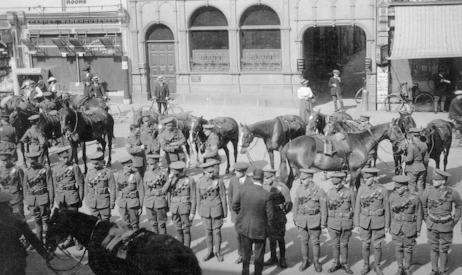
Leicestershire Yeomanry in the centre of Loughborough, November 1914. The researchers also found that there were some common misconceptions about the qualifications for inclusion:
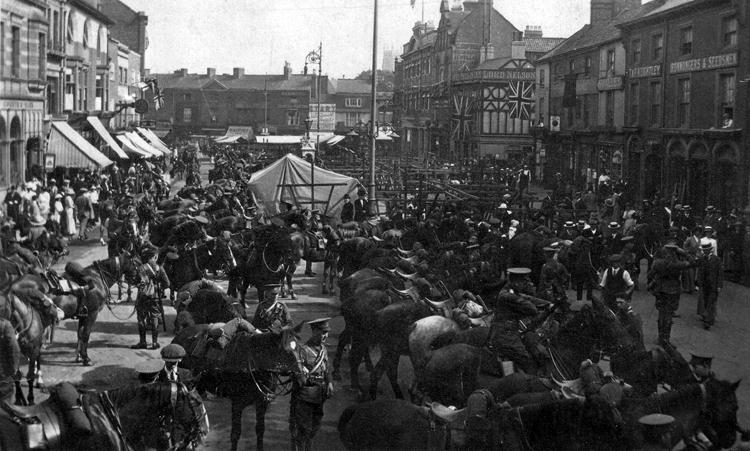 Leicestershire Yeomanry assemble in the Market Place, Loughborough, November 1914.
Some researchers elsewhere in the UK have noted that sometimes a bereaved mother or wife did not wish to be reminded of her loss every time she walked past the local war memorial on her way to the shops. Others have noted that occasionally, when there was a charge payable for the inclusion of a name some families declined to pay, although no evidence has been found that a charge was payable in Loughborough. A New Memorial to the Missing 114 In 2018 the Carillon War Memorial Museum launched an appeal to fund a new memorial to commemorate those servicemen whose names were omitted from the Carillon. Following a most generous donation from Loughborough Grammar School the new memorial was commissioned and crafted in black and gold by Kevin Mitchell. the Loughborough stonemason. The new memorial was unveiled on 3rd November 2018 by the Mayor of Charnwood, Councillor Christine Harris. Marigold Cleeve gave a brief address and the Rev. Wendy Dalrymple, Vicar of All Saints with Holy Trinity Church, Loughborough, gave a blessing. The memorial was subsequently fixed to the wall on the inside of the Ground Floor of the Carillon Tower. 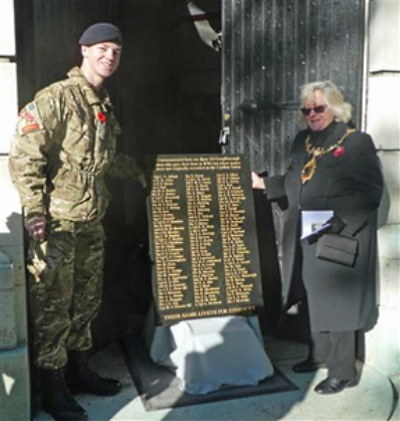 The Mayor of Charnwood unveils the new memorial.
Photograph by Peter Minshall Loughborough’s missing 114 men were properly remembered at last. MLC |

The WW1 Roll of Honour
|
|